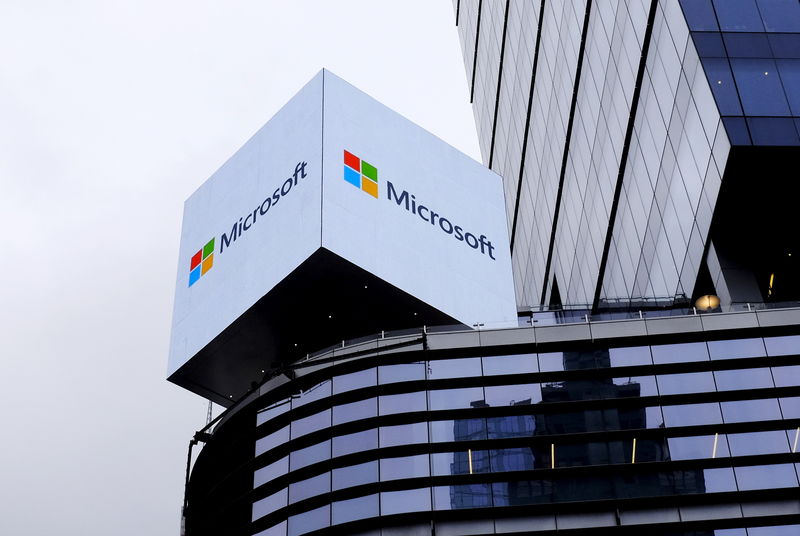Powell’s speech, Nvidia’s chips, Meta deal - what’s moving markets
On Thursday, Guggenheim reiterated a Neutral rating on Microsoft Corporation (NASDAQ:MSFT) following the tech giant’s release of its second-quarter financial results. According to InvestingPro data, Microsoft maintains a "GREAT" financial health score, with revenue growing at 16.44% over the last twelve months to $254.19 billion. Microsoft’s performance fell short of expectations, and its third-quarter revenue guidance for all three business segments did not meet analysts’ projections, even after accounting for increased foreign exchange headwinds since those estimates were set.
The company’s Azure cloud service reported a 31% constant currency (cc) growth, which was at the lower end of their guidance and slightly below the consensus estimate of 32%. Additionally, Microsoft’s guidance for Azure’s growth in the third quarter is 31-32% cc, compared to the Street’s anticipation of 34% cc. This guidance, coupled with a confusing response from management when asked about the expectation of accelerated growth in the second half of 2025, has raised concerns about the company’s forecasting capabilities.
Despite the underwhelming report, Guggenheim does not view this as a critical setback for Microsoft. The firm suggests that while investor confidence in Microsoft’s management forecasts might be shaken, the targets for the third quarter of 2025 appear achievable, perhaps even conservative. The valuation question remains crucial, with InvestingPro analysis indicating the stock is currently trading slightly above its Fair Value. Microsoft’s current P/E ratio stands at 36.48x, with a PEG ratio of 2.09x, suggesting premium pricing relative to growth. Want deeper insights? InvestingPro offers 16 additional valuable tips about Microsoft’s valuation and growth prospects.
The analyst notes that Microsoft’s free cash flow is currently suppressed as the company invests heavily in expanding its cloud infrastructure to meet demand, a strategy similar to that of Oracle Corporation (NYSE:ORCL). The report suggests that belief in Microsoft’s future is necessary, especially given CEO Satya Nadella’s vision for artificial intelligence (AI), which could impact some of Microsoft’s businesses, such as Dynamics.
In conclusion, Guggenheim’s stance remains neutral on Microsoft stock, acknowledging the company’s impressive strides in AI under Nadella’s leadership while maintaining a cautious outlook on the stock’s valuation. Despite trading near its 52-week high, Microsoft maintains strong analyst support, with a highly bullish consensus rating of 1.41 on InvestingPro. For comprehensive analysis including detailed valuation metrics and growth projections, investors can access Microsoft’s full Pro Research Report, part of InvestingPro’s coverage of over 1,400 US stocks.
In other recent news, Microsoft reported a second-quarter revenue of $69.6 billion, marking a 12% increase year-over-year. This was largely due to a significant commitment from OpenAI, contributing to a 33% year-over-year growth in remaining performance obligations. However, Microsoft’s Azure growth for the second quarter was at the lower end of the guided range, with the third quarter guidance also below consensus. Despite these challenges, Microsoft anticipates maintaining similar capital expenditure levels for the next two quarters.
Several analyst firms adjusted their price targets for Microsoft. Bernstein reduced its target from $516 to $511, while Mizuho (NYSE:MFG) Securities lowered its target from $510 to $500. Goldman Sachs maintained a Buy rating and reiterated its $500 target. JPMorgan maintained an Overweight rating with a steady price target of $465, and Morgan Stanley (NYSE:MS) reduced its price target for Microsoft to $530.
These changes come amid recent developments, including Microsoft’s significant expenditures on artificial intelligence (AI) development. Despite concerns about an imbalance between capital allocation and actual usage of the technology, Microsoft’s Chief Financial Officer, Amy Hood, stated that the company’s capital spending would hold steady at approximately $22.6 billion. These are recent developments in the technology sector.
This article was generated with the support of AI and reviewed by an editor. For more information see our T&C.
